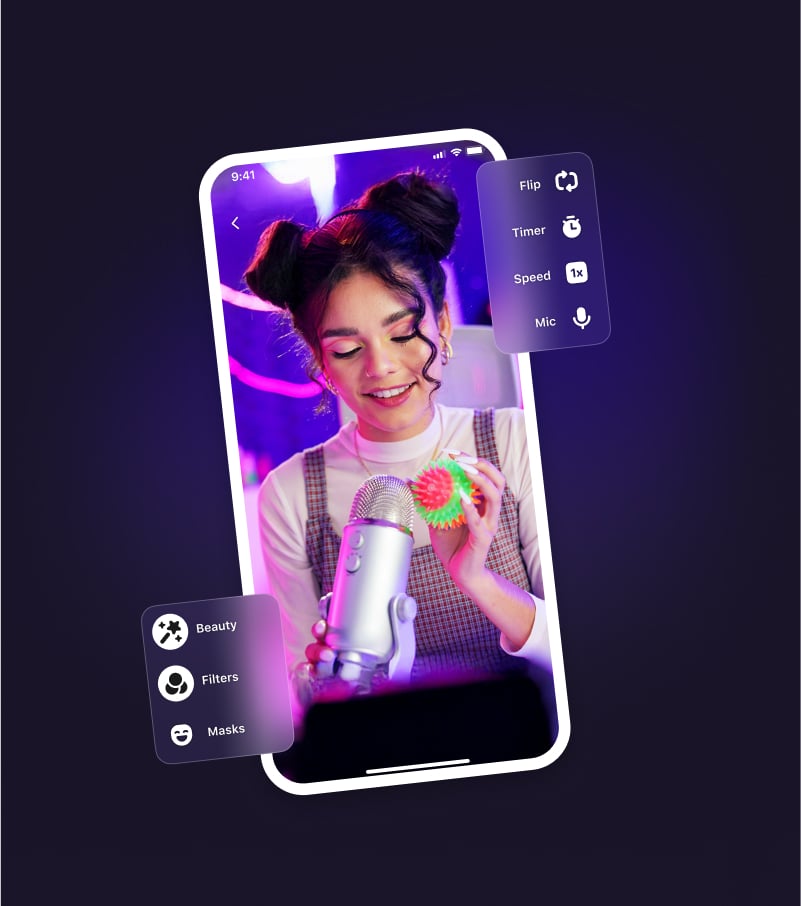Trusted by 120+ clients across the globe












How Banuba’s Live Streaming SDK Works
- Face detection & tracking
- AR face filters
- Background replacement
Key Features of Banuba’s Live Streaming SDK
Multi-face tracking
Real-time beauty filters
3D AR masks
Interactive effects
Virtual backgrounds
Help your streamers keep their location private and save them from potential embarrassment with virtual backgrounds.
Banuba's technology supports static images, videos, GIFs and even 3D environments for maximum creative freedom. In addition, it is precise enough for the person to look natural even under low-light conditions.
Benefits of Augmented Reality
in Live Streaming
Help streamers get better reactions from their audience and gather more donations with live streaming AR effects.
Give creators more tools for making exciting AR streaming content: filters, virtual backgrounds, triggers, and more. All within Banuba Face AR SDK.
Having face AR effects gives you an edge over other streaming services by positioning you as an industry pioneer. Moreover, it attracts users by its “wow factor.”
A simple integration process is built into Banuba Face AR SDK, which lets you quickly add new features and start gaining useful feedback and ROI.
Technical Features
Our virtual webcam features including Face Filters, Face Touch Up and Background Remover run on devices with a 1280x720 camera (recommended) and min 30 FPS.
Mobile
OpenGL ES 3.0+
Android 8.0, API level 26+
iOS 13+
Desktop
OpenGL 4.3+ (4.1+ for MacOS)
Windows 8.1+
MacOS 10.13+
Ubuntu 18.04+
Web
WebGL 2.0+
Mobile: Chrome, FireFox, Safari.
Desktop: Chrome, FireFox, Safari.
How to Integrate Banuba’s Live Streaming SDK
1. Contact us via the form and let us know how we can help you
2. Follow the step-by-step guide and read the docs for more insights
3. Try out the included AR face filters or get more from our asset store
Use Cases of Banuba’s Live Streaming SDK
-
Social Media Broadcasts
Use Banuba API to enhance creator’s streams for their subscribers – or just small shows for friends and family.
-
Virtual Concerts
Let solo musicians and bands excite fans with live augmented reality-powered shows accessible even to those who can’t see them play in person.
-
Interactive Webinars
Make distance education more engaging with 3D learning aids, practical showcases, and AR face effects.
-
AR Conferencing
A professional broadcast and a casual AR stream alike can be improved with an AR changer or features from Banuba’s beauty API.
-
Banuba Face AR SDK offers many filters for live streaming: beauty effects, 3D masks, color filters, triggers, and more. Depending on your goals and needs, you will find ones that fit your business.
-
Yes, you can use Banuba’s SDK for social media apps. Many others in this niche have already done so to great effect. For example, Press Sports raised $2M in investment and managed to increase college offers for student athletes (their main target audience) by 8 times.
-
Yes, Banuba Face AR SDK supports high-resolution video. It has no limitations on the resolution, allowing you to use it in a wide range of applications.
